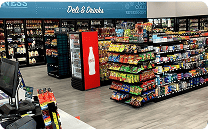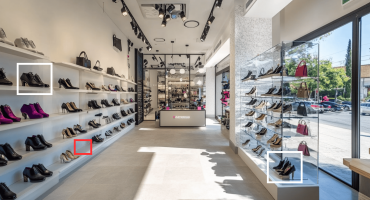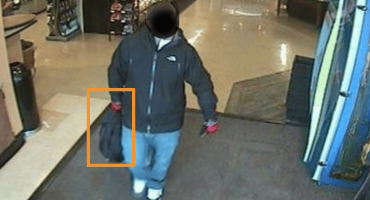In This article
For any business to thrive, sustain its customer base, and operate securely, ownership and management must understand loss prevention vs. asset protection, their differences, and the services to manage them. Although there are differences, loss prevention and asset protection are complementary strategies. Preventing loss from shrinkage (shoplifting, fraud, or employee theft) protects a business’s overall assets. Conversely, when a business proactively addresses asset protection, it creates an environment for maximum loss prevention and where employees and customers feel secure.
Historical Development of Loss Prevention and Asset Protection
The boom in consumerism and the retail market since the 1950s required a greater focus on “loss security,” which evolved into the broader concept of loss prevention. Ownership and management began to understand that loss prevention directly impacted profits and the bottom line. As retailers became more reliant on digital technologies, cybercrime became a new vulnerability, compelling retail businesses to expand their response to loss prevention.
According to multiple sources, inventory shrinkage accounts for more than $100 billion annually in the United States. A 2022 study reported that a significant portion of the billions lost to theft is not stolen inventory but retail assets. Retailers spend many more billions on loss prevention and asset protection expertise and technologies to combat shrinkage from theft, fraud, and waste, especially as many stores experience more crime.
As the retail industry experienced success with its loss prevention strategies, the concept evolved again into asset protection. Those assets encompass inventory, financial assets, employees, exterior and interior physical premises, infrastructure, other holdings, and even relationships with suppliers and financial institutions.
As the world of retail, its supply chains and security and risk management became more complex, retailers, especially small, local businesses, couldn’t allocate the additional time and resources for loss prevention and asset protection. They turned to asset protection services and their expertise for guidance and assistance to improve overall security and reduce risk.
Basic Functioning of Loss Prevention and Asset Protection
The answer to the question, “What is loss prevention?” is relatively straightforward: Reducing shrink. Stopping shoplifting may be the apparent strategy for preventing losses, but loss prevention encompasses many other threats:
- Employee theft (inventory and cash) and fraud.
- Supplier fraud.
- Damage to inventory, property, and other physical assets.
- Organized retail crime.
- Cybercrime.
- Inefficient operations, employee errors, and disregard for safety and health rules.
- Health and safety violations: liability, temporary store closure, and refurbishment/upgrade expenditures to be code-compliant.
With all these loss prevention threats, some unique to specific retail verticals, asset protection services are now required to shield physical and intellectual property and ensure the safety of employees and customers. Although owners, managers, and employees will always be important contributors to loss prevention and asset protection, they don’t have the skills, technical expertise, and time to address all security needs.
Loss Prevention vs. Asset Protection
Successful loss prevention and asset protection are only possible when integrated into a comprehensive security strategy. Despite their complementary functions, loss prevention and asset protection are different enough to require different approaches.
Loss prevention is the means to thwart theft and reduce shrinkage, so a security strategy must address those challenges with specific training, hardware, and other tools. These tools are critical to keeping an eye on what transpires on a store’s floor and the immediate exterior, as well as what occurs behind the scenes: at the cash register, in the backroom, and in the office.
Asset protection is like a giant umbrella, securing a company’s physical, labor, and digital assets. The focus of asset protection is more likely on the risks from damage, organized retail crime, cybercrime, operations, and liabilities, requiring a different subset of strategies in a comprehensive security program. Employee training is equally important, but asset protection covers more internal operations related to fiduciary roles and responsibilities, property upkeep and damage assessment, various audits, regular insurance reviews, and other tools to avoid liabilities.
Services Offered in Loss Prevention and Asset Protection
Employee training is the service most likely to help retailers achieve their loss prevention and asset protection goals. Employees must be the eyes and ears in the shopping environment to prevent shrinkage from theft and fraud, and training by security professionals can create more loyal and trustworthy employees, reducing internal theft and fraud.
However, owners, managers, and employees can’t do the entire job of loss prevention. Comprehensive loss prevention services will include a surveillance strategy and can take the form of security cameras, monitoring equipment, and applications for remote access. Only security specialists can thoroughly assess, plan, and install the right combination of hardware and software for each store’s loss prevention requirements. Ownership and management also need regular incident and reassessment reporting from loss prevention services to identify new vulnerabilities and update training and equipment.
Asset protection services address the unique needs of protecting all the company’s assets. Identifying those assets and their risks and determining the best strategies to protect them is the role of risk assessment specialists. Professional training of employees may focus more on customer transaction procedures, financial management, and securely accessing and using company data. Total asset protection services should also include the training, tools, and technologies to flag and block cybercrime to secure all intellectual property and data critical to business operations. Asset protection services may extend to legal and financial advice and assistance when a business is a victim of cybercrime, and help to recover sensitive data.
Benefits of Implementing Loss Prevention and Asset Protection
Developing and implementing a comprehensive loss prevention plan, asset protection strategies, and service benefits any business in various ways. Financial security is likely at the top of most store owners’ and managers’ minds. Preventing losses from shoplifting and employee theft improves revenues. Proper training and tighter security at the point of transaction reduce credit card fraud and employee theft. Retailers generate more sales from their inventory instead of writing off a portion as shrinkage. By controlling inventory and deliveries more effectively, they also reduce costs.
Stores that rely on loss prevention and asset protection services gain another key benefit: enhanced security. Managers and employees who stay alert help create a secure and welcoming shopping environment. Retailers add another layer of protection by installing the latest security cameras, monitoring equipment, and other technologies. In some cases, they also hire security personnel as part of their protection strategy. When store owners build strong relationships with local law enforcement, they often receive more off-hours patrols and quicker emergency response.
Retailers implementing strong security measures and using top-tier loss prevention and asset protection services also improve operational efficiency. Well-trained employees follow policies and procedures more accurately, making fewer mistakes when processing transactions, managing inventory, or handling office responsibilities. When employees feel safe in their work environment, they stay focused and provide better service to customers.
Case Study Examples
QDOBA Mexican Eatery has benefited from using DTiQ’s SmartAuditTM services to improve employee productivity and internal controls to improve loss prevention. Staff dedicated to watching videos at all locations is unnecessary. The technology has revealed several internal thefts and shown that an employee followed policies correctly when a customer complained, thus saving the employee’s job.
Shrinkage at DXL Big & Tall shops had reached unacceptable levels. Ownership determined that an internal loss prevention team was too expensive to provide adequate assistance and advice to stores across the United States. It partnered with DTiQ to provide much lower-cost loss prevention services. DTiQ’s comprehensive and aggressive program reduced the previous average shrink rate of 4.5% by 70%, which improved earnings by $4.6 million.
Challenges and Limitations
As QDOBA management discovered, an internal loss prevention and asset protection strategic plan can be cost-prohibitive. Even if a company decides to create an internal plan, it may not identify all of the loss prevention and asset protection needs because it is too close to the business. Initial cost estimates may increase significantly to address overlooked needs.
Because technologies are constantly evolving, an internal loss prevention and asset protection team may not have a thorough knowledge of and experience with advanced security technologies. A company could continue to experience shrinkage and gaps in its asset protection without being aware that technological solutions are available.
Employee compliance is another limitation to realizing the maximum benefit of implementing comprehensive loss prevention and asset protection. Instruction and oversight from management could be incomplete and more likely to be met with skepticism and less than total attention by some employees.
Loss Prevention and Asset Protection Services
Fortunately, the solutions to all these challenges and limitations are well-developed, proven, readily available, and affordable. When retailers rely on security firms with total loss prevention and asset protection services, they are more likely to implement and benefit from solutions that address their specific and unique needs and eliminate gaps in store security. Costs are kept low because an overall strategy is precisely what a retailer needs, and nothing more. Plus, loss prevention and asset protection services have experience working with many retail verticals and budget limitations, allowing them to balance costs and budgets more accurately.
Similarly, firms that offer total loss prevention and asset protection services are experts in the latest security technologies. Again, their experience with many retail store environments and the implementation of many technological solutions makes them the best source for determining which combination of technologies will solve a variety of security issues.
Employee training by an independent security firm is more likely to be effective because employees view the trainers as professionals instead of their boss dictating loss prevention and asset protection policies and procedures. Loss prevention and asset protection services know how to instruct employees in a manner that results in maximum compliance.
These firms can also provide regular security audits and assessments, for which retailers don’t have the time or the expertise to recognize security gaps and which services will close them.
Conclusion
There are many moving and interlocking parts to the successful operation of any business, including retail stores. Labor and appealing inventory may first come to mind, but loss prevention and asset protection have become equally critical in the 21st-century mercantile market.
Loss prevention strategies primarily focus on reducing shrinkage from shoplifting, employee theft, supplier fraud, and increasing organized retail crime, which can result in significant damage to retail property.
Although closely aligned with loss prevention, asset protection involves securing all assets of a business or store: inventory, property, equipment, finances, and sensitive data. Intangibles, such as relationships with suppliers and financial and other business institutions, are also assets.
Despite the attacks from without and within on retail stores, loss prevention and asset protection services offer proven strategies, expertise, and technologies to thwart those attacks and identify those responsible. However, all businesses, including retailers, must take the first step. The solutions are available, and investing in them will deliver an ROI to boost the bottom line.
Contact our sales team to learn more about DTiQ’s loss prevention programs.
Frequently Asked Questions
Q: What is loss prevention, and how does it help businesses?
Loss prevention refers to strategies implemented to reduce shrinkage from many vulnerabilities, from shoplifting to employee theft, supplier fraud, organized retail crime, and cybercrime. With a comprehensive loss prevention program, businesses can be more profitable, operate more efficiently, sustain their operations for many years, and provide a safe and secure working and shopping environment.
Q: How do asset protection services differ from loss prevention services?
Although closely related and often offered by market-leading security firms, asset protection services address the total array of a business’s assets, tangible and intangible, physical and digital. Loss prevention services focus on the causes of shrinkage on the store floor, at the point of transaction, in the back room, and in the office. Comprehensive loss prevention services will include specific employee training to make them more observant. Properly placed security cameras and monitoring equipment will identify and stop shoplifters and employees committing theft. Loss prevention experts will also recommend RFID (Radio Frequency Identification) and other advanced technologies to protect inventory.
Q: Can small businesses benefit from asset protection strategies?
Most definitely, because they typically don’t have a clear picture of all their assets, and they don’t have the time to determine the best asset protection strategies and implement them. Organized retail crime may target small businesses because those criminals know small businesses are less likely to have sophisticated security measures. For the same reason, small businesses are more vulnerable to cybercrime. Small businesses operate on low margins, and sales and profits can fluctuate. Any efforts to protect assets secure the bottom line and help sustain those small businesses.
Q: What are the key services offered by loss prevention experts?
A thorough assessment of a store’s layout, point of transaction, and inventory storage and handling is often the first service loss prevention experts will recommend. They will also review a store’s floor space to determine where security cameras should be located or recommend upgrades to existing cameras. Advanced monitoring equipment and remote-viewing apps are essential to maximizing the value of a camera system. Loss prevention experts know employee training is another key service, so they are more vigilant on the floor and when handling transactions.





























